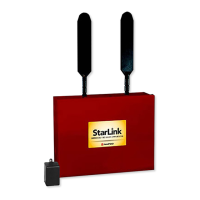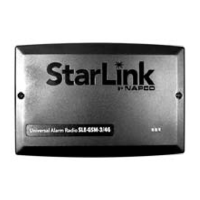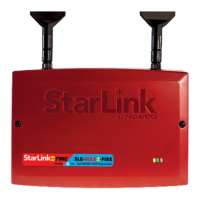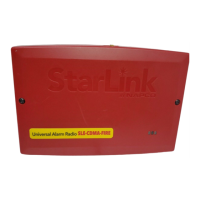StarLink
™
SLE-LTE Commercial Series Alarm Communicators -- Installation Instructions 17
Option
Application
Armed Disarmed
Resend
TBL every
24 Hrs.
NOC Inputs
"Function"
Selection
Comments
Cut
Wire*
Open Short
Cut
Wire*
Open Short
FACP with DACT
Use IN2 or IN3 only for
trouble. Panel reports via
dialer capture, but Linecut
for DACT interconnection
wiring to the radio reports via
an input on radio.
TBL TBL TBL - - - Yes
Supervised Fire
Trouble (Linecut)
Requires two EOLRs. Radio reports in CID
(use jumpers 4/5)
-- -- -- - - - Yes
User Defined
Unsupervised Fire
Trouble (Linecut)
Non-supervised (use conduit max 20 feet
Commercial Fire or 3 feet Residential Fire)
(remove jumpers 4/5).
2
FACP with DACT
Use IN1 (not supervised)
either for trouble or alarm.
Panel has trouble (or alarm)
relay that closes on the
condition.
-
TBL
(or
ALARM)
- - - - Yes
Un-Supervised Fire
Trouble (use 'User
Defined' selection
for Alarms)
Non-supervised (use conduit activation
requires +12V or 12/24V)
3
FACP without DACT
Use IN2 or IN3 for both
Alarm and Trouble on one
input. Panel has alarm and
trouble relay outputs.
TBL TBL ALARM - - - Yes
Supervised Fire
Alarm/Trouble
Requires two EOLRs. The Trouble relay
N.O. contact (de-energized opens) is put in
series with one EOLR. Alarm relay put
across both EOLR and trouble relay.
4
BURG with DACT
Use IN2 or IN3 for only
trouble reporting. Panel
reports via dialer capture but
Linecut for DACT intercon-
nection wiring to the radio
reports via an input on radio.
ALARM ALARM ALARM TBL TBL TBL No
Supervised Burg-
Linecut
Requires two EOLRs. Program panel to
report Open/Close (radio remembers last
state of panel for Napco panels when used
with local download cable).
5
BURG without DACT
Use IN2 or IN3 for both
Alarm and Trouble. Panel
has alarm and Trouble
Relay/PGM outputs. Two
EOLRs are needed since for
UL Burg it is required to
detect both wire breaks and
shorts.
ALARM TBL ALARM TBL TBL TBL No
Supervised Burg
Alarm/Trouble
Requires two 10K EOLRs. Three off nor-
mal conditions can be detected, namely,
cut wire, shorted loop and one of the
EOLR's having a closed contact in series.
The Trouble relay N.O. contact (de-
energized opens) is put in series with one
EOLR. The Alarm relay N.O. contact is put
across both EOLRs and trouble relay. The
panel Armed or Disarmed state is deter-
mined by a separate input (see Option 6 in
this table below for armed status opera-
tion). (Note: The Alarm relay should NOT
activate on 24hr zones.)
6
BURG without DACT:
Armed Status
Use IN2 or IN3 for Armed
Status input. Two EOLRs
are needed since for UL
Burg it's required to super-
vise for both wire breaks and
shorts.
TAMPER
ALARM
N/A ALARM TBL N/A TBL No
Supervised Arm/
Disarm Status
Requires two 10K EOLRs. A relay or PGM
for Arm/Disarm status goes in series with
one EOLR where open is disarmed and
closed is armed. The other EOLR is across
the series combination (relay for Arm/
Disarm and first EOLR) to provide the loop
supervision.
1
Input Configuration Options
*Note: On line cut, PGM1 will activate.
REN = 0. The Ringer Equivalence Number (REN) indicates the maximum number
of devices allowed to be connected to a telephone interface. The termination of an
interface may consist of any combination of devices subject only to the requirement that
the sum of the RENs of all the devices not exceed five (5).

